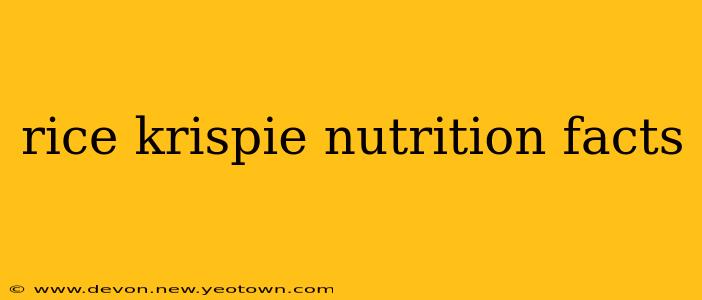Let's be honest, Rice Krispies hold a special place in many hearts. That nostalgic crunch, the simple sweetness... it's a childhood favorite that often follows us into adulthood. But beyond the delightful taste, what's really in those little rice puffs? This deep dive into Rice Krispies nutrition facts will unravel the nutritional profile of this iconic cereal and answer some common questions.
What are the basic nutritional facts of Rice Krispies?
A single serving (typically about 1 ounce or 3/4 cup) of Kellogg's Rice Krispies offers a surprisingly simple nutritional profile. While the exact numbers might vary slightly depending on the specific packaging and updates from Kellogg's, you'll generally find that a serving contains roughly:
- Calories: Around 100-110
- Carbohydrates: Approximately 23-25 grams, primarily from sugars and starch.
- Sugars: About 3-4 grams. While not overly sugary compared to some cereals, it’s worth noting.
- Fat: Minimal, typically less than 1 gram.
- Protein: About 2 grams.
- Fiber: A very small amount, usually less than 1 gram.
It’s important to always check the nutrition label on your specific box of Rice Krispies, as these numbers can fluctuate slightly.
Are Rice Krispies healthy?
This is a question that sparks much debate. The answer, like most things in nutrition, is: it depends. Rice Krispies, on their own, aren't inherently "unhealthy." They're low in fat and relatively low in sugar compared to many other breakfast cereals. However, they are also low in fiber and protein, meaning they won't keep you full for long.
The health implications really depend on how you consume them. A small serving as part of a balanced breakfast, perhaps paired with fruit and yogurt, is much different from eating a large bowl with a generous helping of sugary milk.
How many calories are in a bowl of Rice Krispies?
The calorie count drastically changes based on serving size and what you add. A standard serving, as mentioned above, sits around 100-110 calories. However, a larger bowl, say 1.5 cups or more, could easily double or even triple that number. Adding milk significantly increases the calorie and sugar content. The type of milk used (whole milk versus skim) also dramatically affects the total calories.
What are the ingredients in Rice Krispies?
Kellogg's Rice Krispies primarily consist of rice, sugar, and salt. They may also contain small amounts of additional ingredients for flavor and processing. Always check the ingredient list on the package for the most up-to-date and accurate information, as formulations can change.
Are Rice Krispies gluten-free?
Yes, Rice Krispies are generally considered gluten-free. However, always double-check the label on the box to confirm, as manufacturing processes can sometimes lead to cross-contamination. Kellogg's usually explicitly labels their Rice Krispies as gluten-free, but it's best to be cautious if you have a severe gluten intolerance.
What are the benefits and drawbacks of eating Rice Krispies?
Benefits:
- Low in fat: A relatively healthy choice compared to many other breakfast cereals.
- Quick and easy: A simple and convenient breakfast option.
- Nostalgic comfort food: Many people enjoy the taste and texture.
Drawbacks:
- Low in fiber and protein: Doesn't offer much in the way of sustained energy or satiety.
- Low in essential vitamins and minerals: It's not a significant source of micronutrients.
- Added sugar: While not excessively high, the added sugar content contributes to overall daily sugar intake.
In conclusion, Rice Krispies can be a part of a healthy diet in moderation, but they shouldn't be relied upon as a primary source of nutrition. Consider them a treat rather than a staple food, and always be mindful of your portion size and what you add to them.

